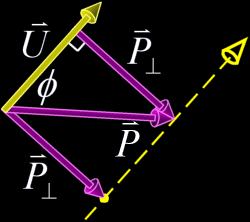|
Plücker Coordinates for the Rest of Us - Part 3 by Lionel Brits (15 November 2001) |
Return to The Archives |
Back to Reality
 |
|
Of course we must also be able to work backwards; that is, we
must be able to find the line, if it exists, that corresponds to a Plücker
coordinate. Given a coordinate In particular, we know that: After rearranging the above equations, finding  Since any point on the line would be a solution of this system, we know that the system has infinitely many solutions (it is undetermined), and thus the coefficient matrix has no inverse. We could proceed by row reduction or whatever method. The general solution would to this system would have the form An easier way to proceed was pointed out to me by Conor Stokes. The vector Consider the point  Marvelous! We can now decompose  . .
|
An Alternate Representation
 |
|
We have so far treated the Plücker representation of a line as
a 6D coordinate, Or alternatively, given a line from point For this representation the corresponding version of the permuted inner product is: This representation of the Plücker coordinate corresponds to a hyperplane containing all lines in 3D that intersect the line it represents. Though not a plane in the familiar sense, it is a hyper plane because it divides the Plücker-space into two (lines outside either have CW or CCW relationship with the line the hyper plane represents). This representation of the product has the property that it is zero whenever |
What is it Good For?
 |
| Oodles! Go right ahead and find out. |
|
Article Series:
|